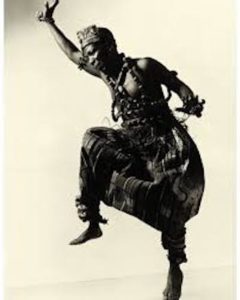
Asadata Dafora
*Asadata Dafora was born on this date in 1890. He was a Black multidisciplinary musician. He was among the first Africans to introduce African drumming music to the United States.
Austin Dafora Horton was born into the Creole ethnic group in Freetown, British Sierra Leone. The son of John 'Johnnie' Warner M. Horton, the Freetown city treasurer, and his wife, a concert pianist. Dafora grew up in a privileged household. His half-sister was Constance Cummings-John, a well-known Creole Pan-Africanist. Dafora received a European education at the Wesleyan School in Freetown. However, he always kept a keen interest in studying indigenous African culture, especially traditions, languages, and 17 distinct African dialects.
Dafora traveled to Europe as a young man and studied at several opera houses in Italy to advance his musical training and learn English. French. Spanish. German and Italian. His crossover from choral music into the medium of dance happened when he went to a performance of West African songs in a German nightclub in 1910, and overwhelmed with homesickness, he broke out into traditional African dance. His performance was so well-received that the club owner contracted him to train a group of dancers. While touring with his dance troupe, Dafora was struck by how ignorant most people were about Africa and dedicated the rest of his career to exposing people to African culture.
In 1929, Asadata Dafora came to New York City to try to pursue his career as a musician. He was then 39 years old. Despite his talent, at the start of the Great Depression, creative performing careers were difficult to maintain, particularly for foreign African performers. However, his interactions with a group of African men at the National African Union soon led him back to his interests in African dance. The company he formed was called Shogolo Oloba (sometimes known as the Federal Theater African Dance Troupe and Asadata Dafora Horton and his African Dancers). It strove to portray African culture in a complex and sophisticated way, not just an exotic array of mysterious spectacles.
Because he strove for authenticity in his work, Dafora preferred to use native African dancers and trained them in African dialects and performance techniques. Dafora is credited with developing dance drama, a type of production that fully integrates narrative and song into a dance performance. Furthermore, Dafora was the first to stage an African ritual in a Western-style stage production successfully. His first work, "Kykunkor" (Witch Woman), completed in 1931, was based on African folklore. It opened in 1934 and was such an overwhelming success that it had to move to a larger theatre to accommodate the audience. He was also the choreographer and drummer in a 1936 stage success, Orson Welles's all-Black Voodoo Macbeth, performed in Harlem, on Broadway, and on a national tour. With his collaborator, Abdul Assen, he helped create the unique sound and feel of the Haitian "voodoo" sections of the performance.
He toured with his works "Awassa Astrige/Ostrich" (1932), "Zunguru" (1940), and "Batanga" (1941). He also co-authored a radio play with Orson Welles entitled "Trangama-Fanga." Around 1950, Dafora founded the Academy of Jazz. He has also been the subject of a film by Kinsley Mbadiwe called The Greater Tomorrow. In 1960, Asadata Dafora returned to Sierra Leone, where he became the cultural director of the newly independent nation. His contributions to the dance world influenced many future artists, especially black artists such as Pearl Primus, Esther Rolle, and Katherine Dunham. Asadata Dafora died in a hospital in Harlem, New York, on March 4, 1965.